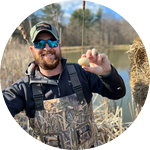About This Project
The captive breeding and the genetic dynamics of wild populations has long intrigued ecologists. This research delves into the effects of mallard hen house nesting structures on the survivability and genetic propagation of feral game farm mallard genetics within wild populations. Mallards (Anas platyrhynchos) are an ecologically significant waterfowl species, and understanding the impacts of these nesting structures is vital for conservation aimed at preserving population health.
Ask the Scientists
Join The DiscussionWhat is the context of this research?
This research project aims to investigate how mallard hen house nesting structures influence the integration of feral game farm mallard genetics into wild populations. By studying nesting habits and genetic traits, the project seeks to understand if these structures inadvertently facilitate gene flow, impacting the genetic diversity and adaptability of wild mallard populations. The findings will shed light on potential ecological consequences and inform conservation strategies to maintain the natural genetic integrity of wild mallards
What is the significance of this project?
Studying hen house nesting structures' impact on game farm mallard genetics in wild populations is crucial due to its potential ecological and conservation implications. This research addresses the intricate interplay between captive and wild populations, which is especially pertinent for maintaining genetic diversity and preventing negative outcomes.
By assessing how nesting structures influence gene flow between captive and wild mallards, the study can shed light on whether game farm genetics are inadvertently infiltrating wild populations. This insight is pivotal for biodiversity conservation as interbreeding can dilute wild gene pools and compromise local adaptations essential for species' survival in their respective habitats.
What are the goals of the project?
The desired goal of this project is to evaluate the genetic composition of wild mallards found utilizing these hen house nesting structures, and determine if there is a higher prevalence of feral game farm mallard genetics within the population utilizing these structures. By evaluating these genetics we can assess if the use of these hen house structures are influencing the spread of this feral DNA into the wild populations, perpetuating their loss of natural nesting, migratory, and predator avoidance mechanisms.
Budget
The budget for this project focuses on the construction of mallard hen house structures, and all the materials and labor to fabricate these engineered structures. This line item in the budget allows for the purchase of steel tubing, caging, welding consumables, bedding and nesting materials, as well as help offset labor and fabrication costs.
The genetic sampling of this project, is tedious to complete and includes the need for gear such as microcentrifuge tubes, freezer boxes, coolers, and other specialized gear to handle and transport genetic material. In addition to this, running samples in the lab costs roughly $30-40 per sample, which can quickly add up.
The field gear includes the purchase for construction of live capture traps, as well as the purchase of pre-made designs. It also includes the purchase of holding containers, biometric field supplies, bands, and other items required to properly handle and collect biological metrics off of live captured birds.
Endorsed by
 Project Timeline
Project Timeline
This project will be a part of a self-funded PhD multi-year project, and is currently ongoing with a total of 31 nesting structures installed on both ODNR public land, as well as numerous private lands.
Feb 29, 2024
Complete Construction and Installation of Mallard Hen House Nesting Tubes
Mar 31, 2024
Begin Observing Nest Utilization by Wild Mallards
Apr 30, 2024
Live Capture Nesting Birds and Collect Genetic Samples and BioMetrics
May 18, 2024
Gather and Record Clutch Data
Jun 30, 2024
Evaluate the biological data of any ducklings present, and calculate hatchability rates and duckling success.
Meet the Team
Affiliates
Eric Lance
I am a professionally certified wildlife biologist and natural resource professional based out of Ohio who holds a bachelor of science degree in biology from Kent State University, and a master's degree in natural resources from Virginia Tech. I work as a wildlife consultant all across the Midwest, while also serving as adjunct faculty in the department of Biological Sciences at Kent State University.
Project Backers
- 0Backers
- 0%Funded
- $0Total Donations
- $0Average Donation

